Scott’s long-travel enduro-ready Ransom eRide 910, one of our eMTB Bike of the Year contenders, runs on 29in wheels front and rear, backed up by a bump-munching 180mm of travel, controlled by Scott’s Virtual 4 Link Kinematic (VLK) suspension.
Its aluminium frame features adjustable geometry, while it’s specced with some top-performing parts, including Fox’s 38 Performance Elite fork, Float X2 Performance shock and a SRAM drivetrain.
Given its spec, the Ransom eRide is reasonable value for money at £6,499 / €7,199 / AU$14,500.
It’s driven by Bosch’s Performance Line CX motor with 85Nm of torque that’s powered by Bosch’s 625Wh-capacity PowerTube battery, the same as is fitted to Whyte’s E-180 RS v3, another of our Bike of the Year machines.
Scott Ransom eRide 910 frame and suspension
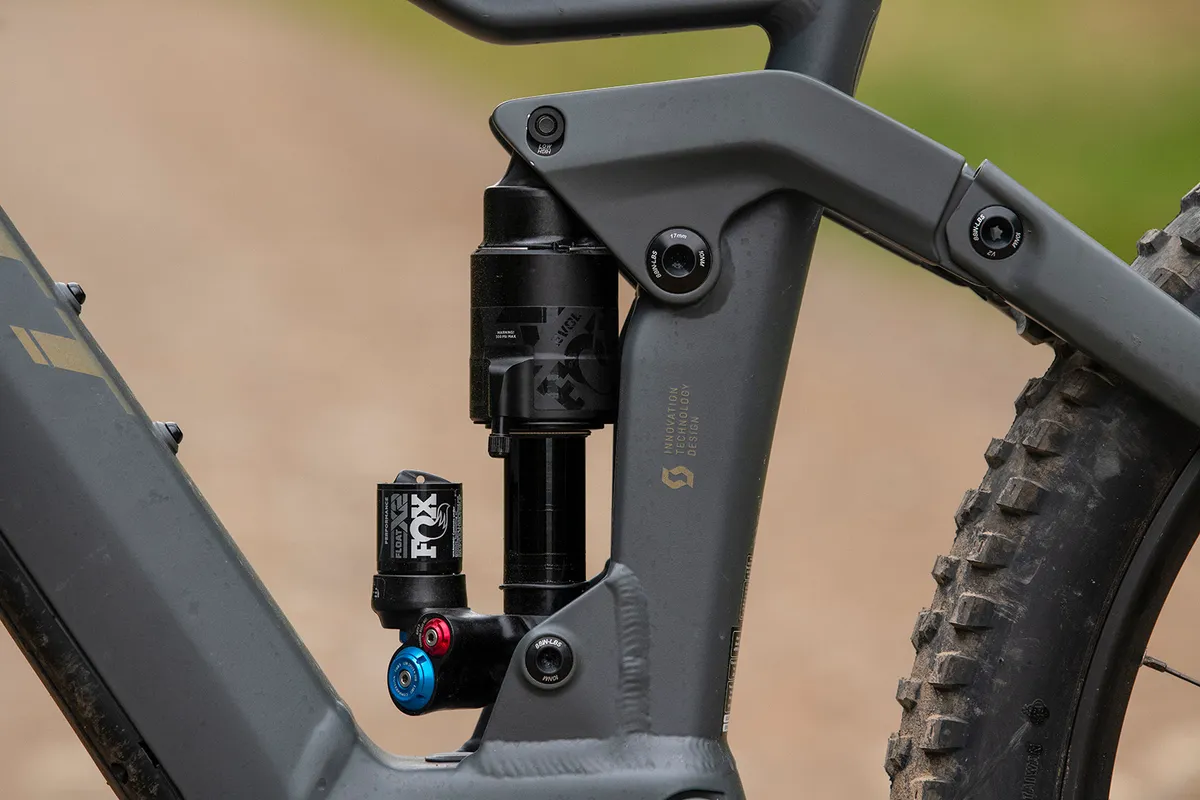
The silhouette of the aluminium Ransom eRide frame resembles the current Scott Genius and Scott Ransom bikes, and the previous-generation Spark, featuring a vertically mounted rear shock.
Its cables are routed internally from the headset to their exit points at the rear of the chainstays, and it has in-built chain slap protection on the driveside stay.
It has a straight, uninterrupted seat tube that means increased dropper post insertion is possible.

Although it’s factory-specced with 29in wheels front and back, it’s compatible with 27.5in wheels set up as either a mullet (29in front, 27.5in rear) or 27.5in front and rear thanks to a geometry flip chip on the shock mount.
This flip chip can also be used with 29in wheels to swap between a high and low setting.
It’s fitted with Syncro’s Fork Stop Headset that limits fork rotation to 60 degrees to avoid the fork crown and down tube damaging each other.
Suspension kinematics
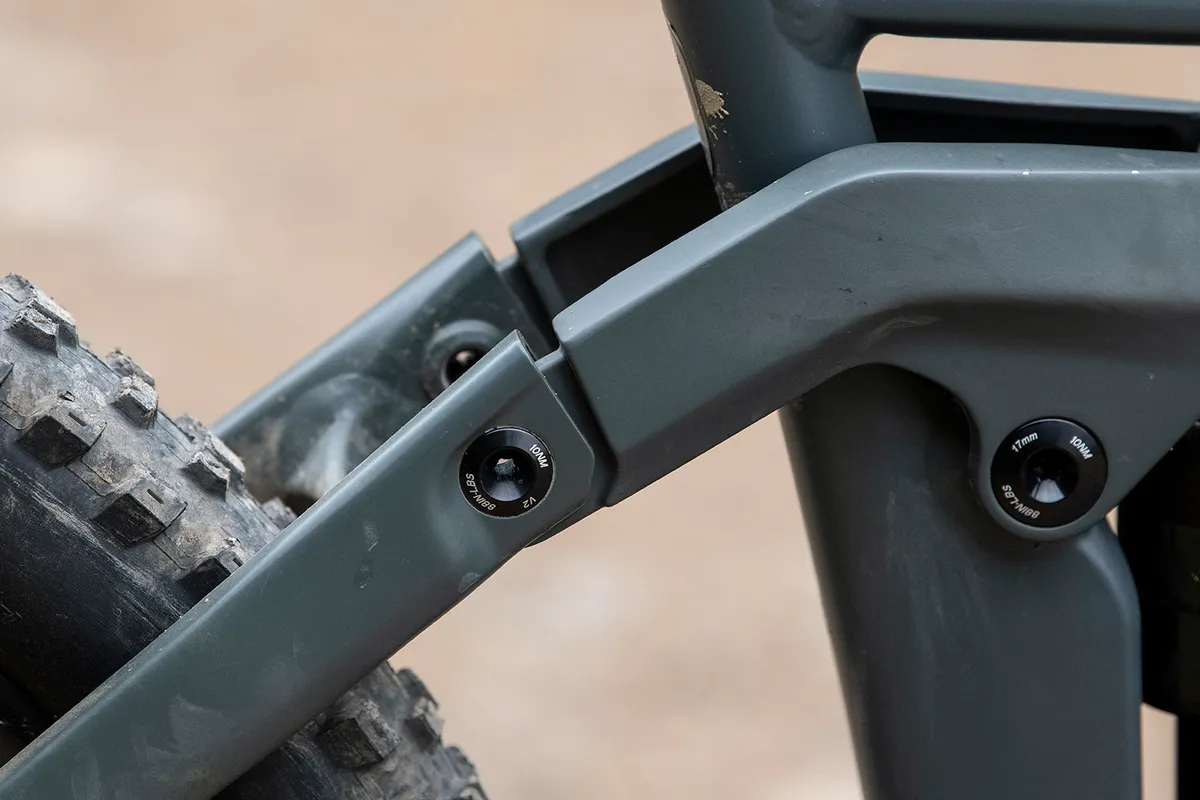
The Ransom eRide’s 180mm of rear-wheel travel is driven by a Horst-link suspension design, where the rear wheel axle sits behind the chainstay/seatstay pivot.
Scott says it has made the first part of the suspension’s travel sensitive to improve small-bump compliance and it then gets firmer towards bottom-out, claiming these kinematics are tailored to the needs of an electric enduro bike.
In terms of numbers, the Ransom is roughly 23 per cent progressive through its travel. This means it isn’t the most or least progressive bike in its category and is best suited to air-sprung shocks, where volume-reducer spacers can be added to increase progression.
The frame uses a metric trunnion-mounted shock. Unusually, the trunnion mount is attached to the frame rather than the rocker linkage. This means the linkage drives the shock via DU eyelet bushings, and as the linkage compresses it rotates around the shock’s eyelet.
The bearings in a trunnion-mounted shock – if the trunnion mount is on the linkage end – reduce the wear and friction associated with that rotation, resulting in smoother suspension and longer service intervals.
Unfortunately, this major benefit of a trunnion shock isn’t applicable to the Ransom eRide because the main frame trunnion mount undergoes limited rotation during compression.
Scott Ransom eRide 910 battery and motor
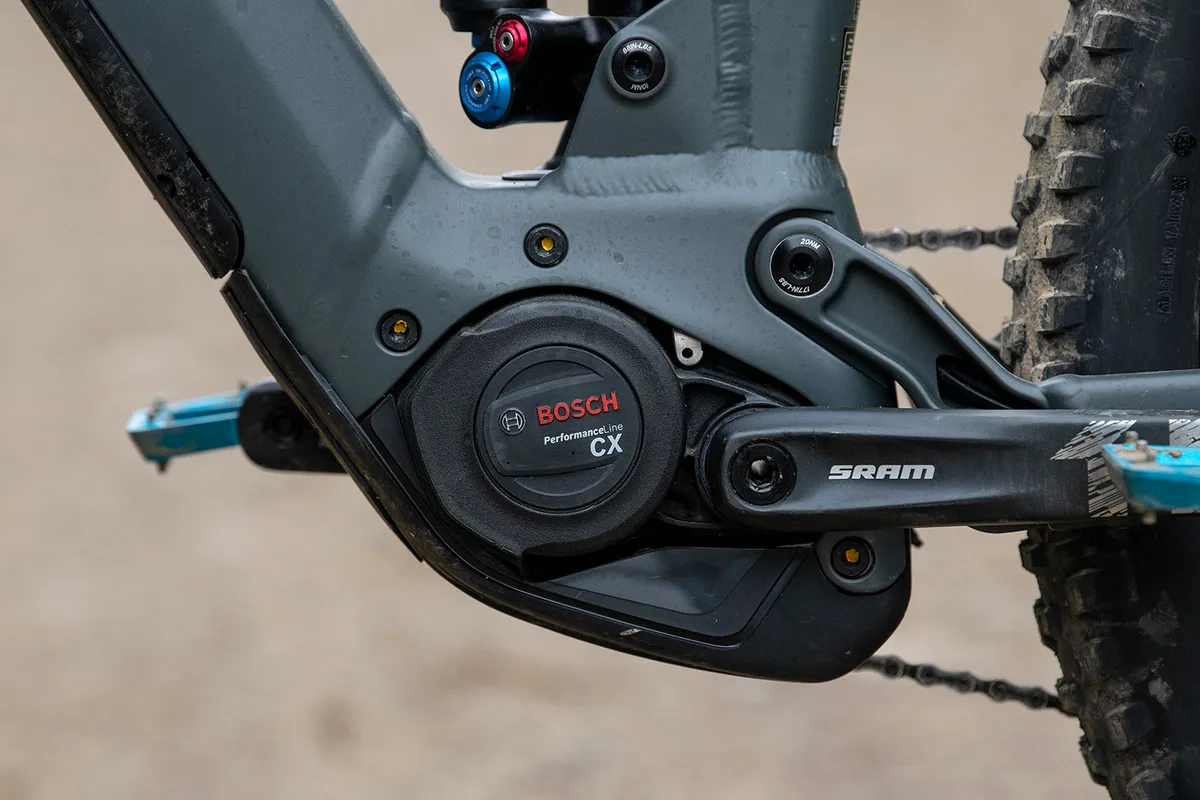
The Ransom is fitted with Bosch’s Performance Line CX motor with 85Nm of torque and 250w of assistance, equalling that provided by Shimano’s EP8 but trailing just behind the Specialized/Brose unit.
The Ransom’s motor is paired with a 625Wh battery and uses the Purion display and controller that lacks any form of Bluetooth or smartphone connectivity.
It has four riding modes: Eco, Tour, eMTB and Turbo, as well as a walk mode.
Scott Ransom eRide 910 geometry
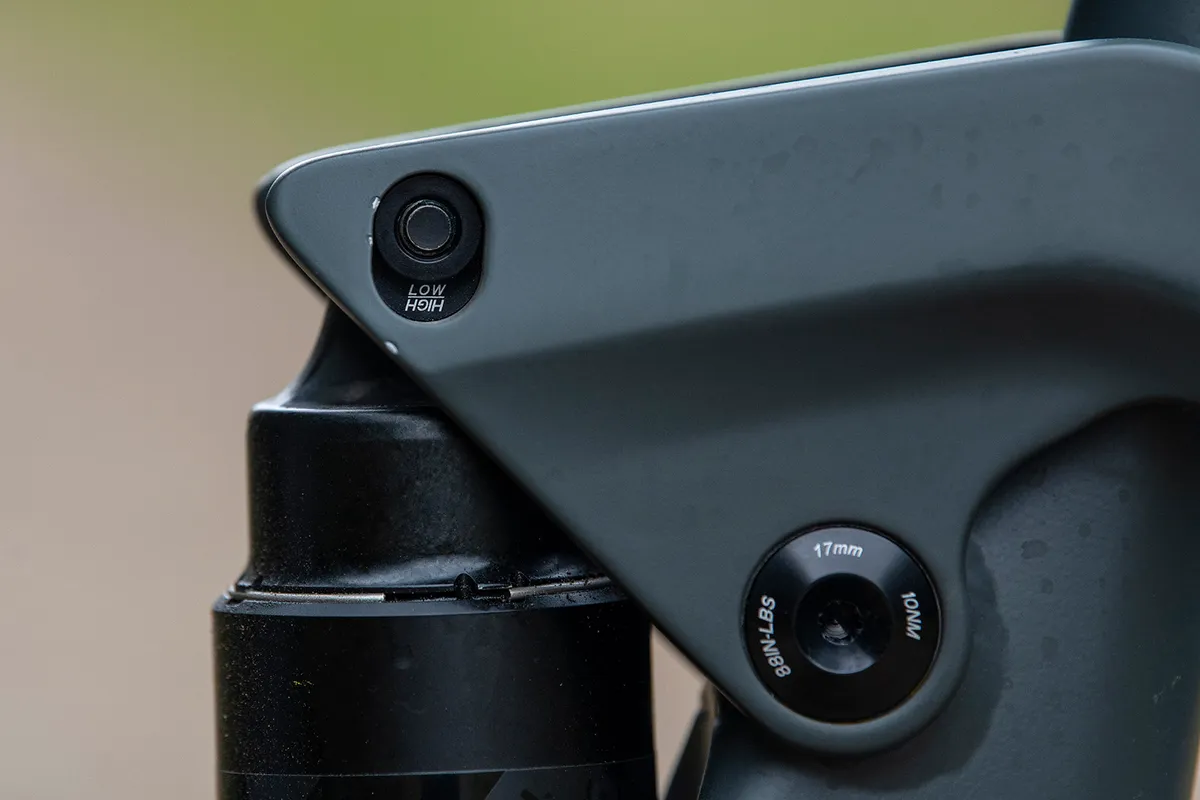
Scott claims the Ransom’s geometry is “long, slack and stable at speed”, and is ready to tame the descents. The brand also says seat tube angles haven’t been compromised, understanding the importance of seated pedalling comfort. It’s available in four sizes, from small to extra-large.
For my 178cm height, I picked the size large Ransom. With 29in wheels and in the low setting, it has an average-sized 470mm reach, a 353.5mm bottom bracket height and a long 1,285.6mm wheelbase.
Its head angle sits at 64 degrees, while the seat tube is 76.1 degrees. The chainstay figure, even for an electric mountain bike, is long at 465mm.
All good so far, however there is an outlier: the seat tube length. Although it has good insertion depth, it is very long at 470mm. This has the potential to limit shorter riders sizing up to get longer reach figures.
| | S | M | L | XL |
|---|---|---|---|---|
| Seat angle (degrees) | 76.5 | 76.3 | 76.1 | 75.9 |
| Head angle (degrees) | 64 | 64 | 64 | 64 |
| Chainstay (mm) | 465 | 465 | 465 | 465 |
| Top tube (mm) | 568 | 595.5 | 628.8 | 600.7 |
| Head tube (mm) | 120 | 120 | 125 | 125 |
| Trail (mm) | 136.4 | 136.4 | 136.4 | 136.4 |
| Bottom bracket drop (mm) | 22 | 22 | 22 | 22 |
| Bottom bracket height (mm) | 353.5 | 353.5 | 353.5 | 353.5 |
| Wheelbase (mm) | 1,230.30 | 1,255.30 | 1,287.50 | 1,317.50 |
| Standover (mm) | 762 | 766 | 790 | 800 |
| Stack (mm) | 644.4 | 644.4 | 649 | 649 |
| Reach (mm) | 415 | 440 | 470 | 500 |
Scott Ransom eRide 910 specifications
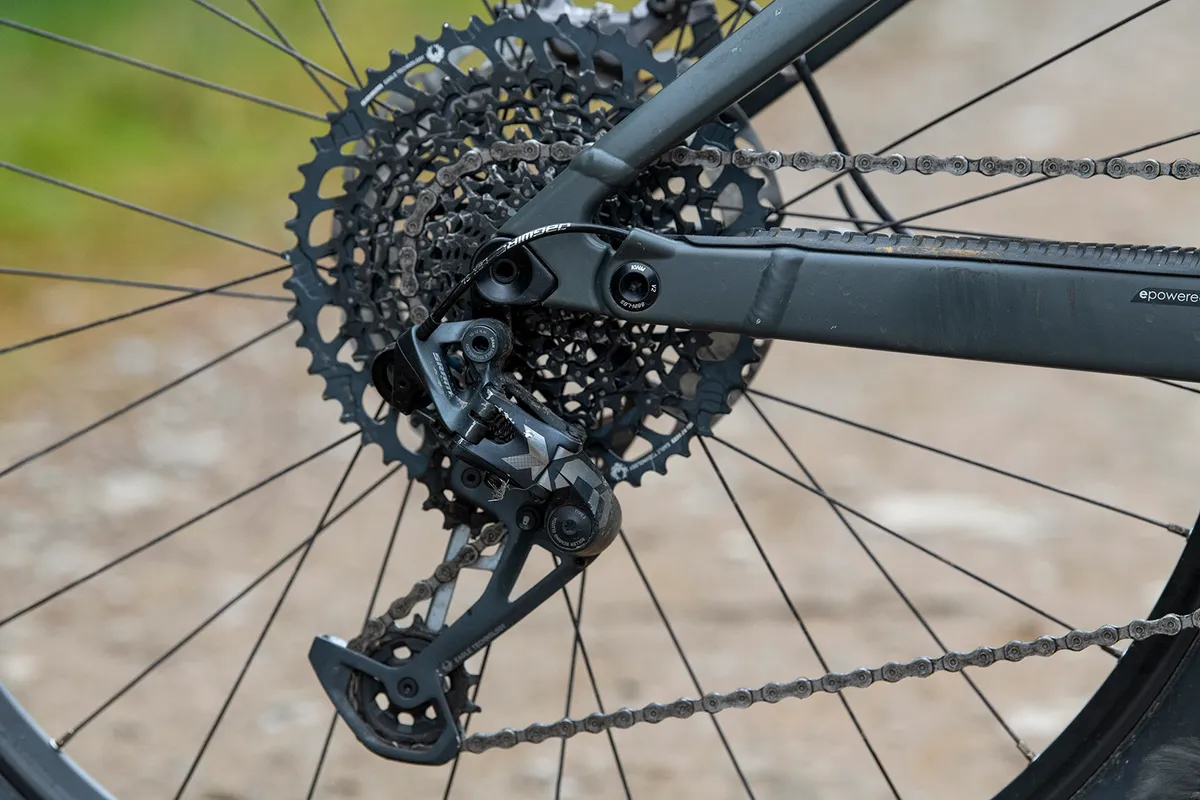
In terms of components, the Ransom represents good value for money, with Scott speccing high-performance parts in crucial areas.
The Performance Elite Fox 38 has both low- and high-speed rebound and compression adjustment thanks to the GRIP2 damper, while its marginally less sophisticated X2 Performance shock still has plenty of adjustment and damper control.
Rounding out the Fox stable is a Transfer dropper post with 175mm of travel.
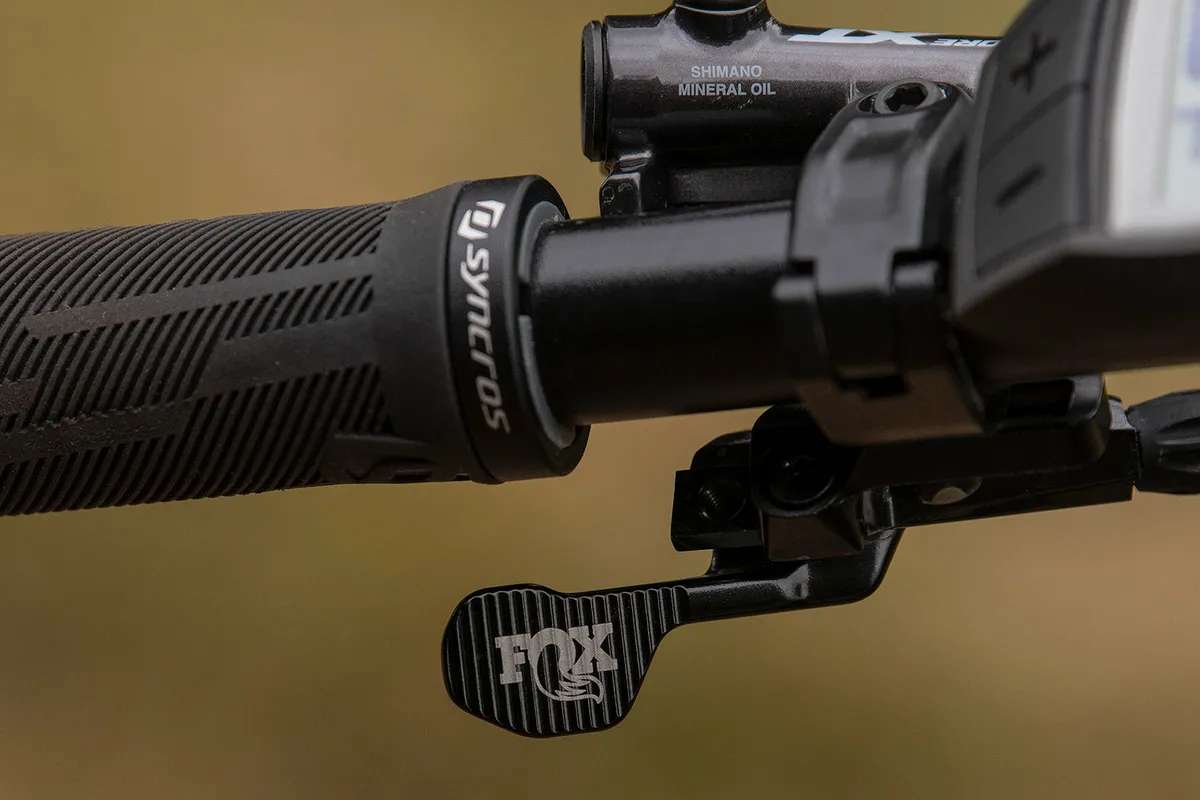
It’s fitted with a SRAM X01/SRAM NX Eagle drivetrain mix with single-click shifting.
It has Shimano’s XT M8120 brakes with 203mm rotors and Scott house-brand finishing kit from Syncros, including bar, stem, saddle and rims.
Its wheels are wrapped in 29x2.6in wide Maxxis rubber, but both tyres feature the lighter EXO+ casing and less sticky MaxxTerra compounds. The front Assegai is matched with a Dissector rear; an unusual back tyre for such an aggressive enduro bike.
Without pedals, my size-large test bike weighed 24.87kg.
Scott Ransom eRide 910 ride impressions
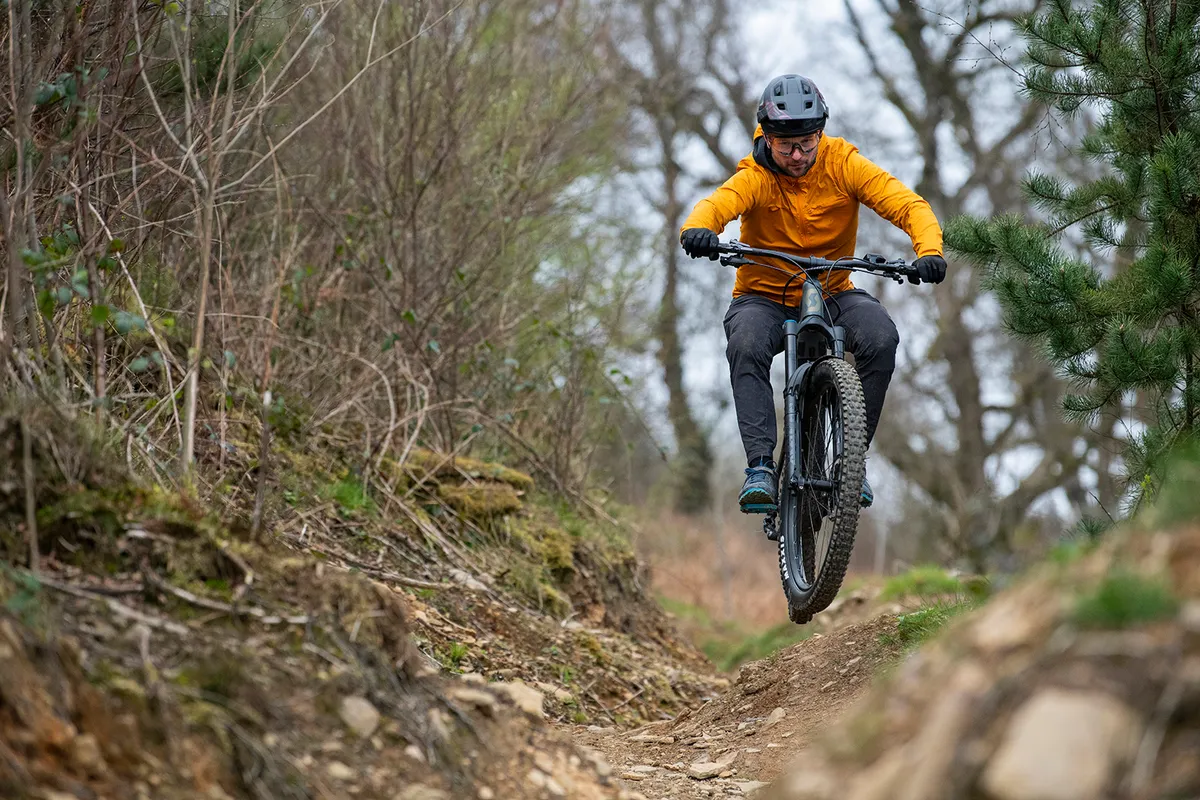
I tested the Scott Ransom on the trails used for the UK’s round of the Enduro World Series, with terrain ranging from flat-out DH runs, to steep on-the-brakes secret singletracks hidden deep in the woods.
Conditions ranged from dry and dusty through to muddy gloop and seriously wet-as-a-river trails.
Scott Ransom eRide 910 setup
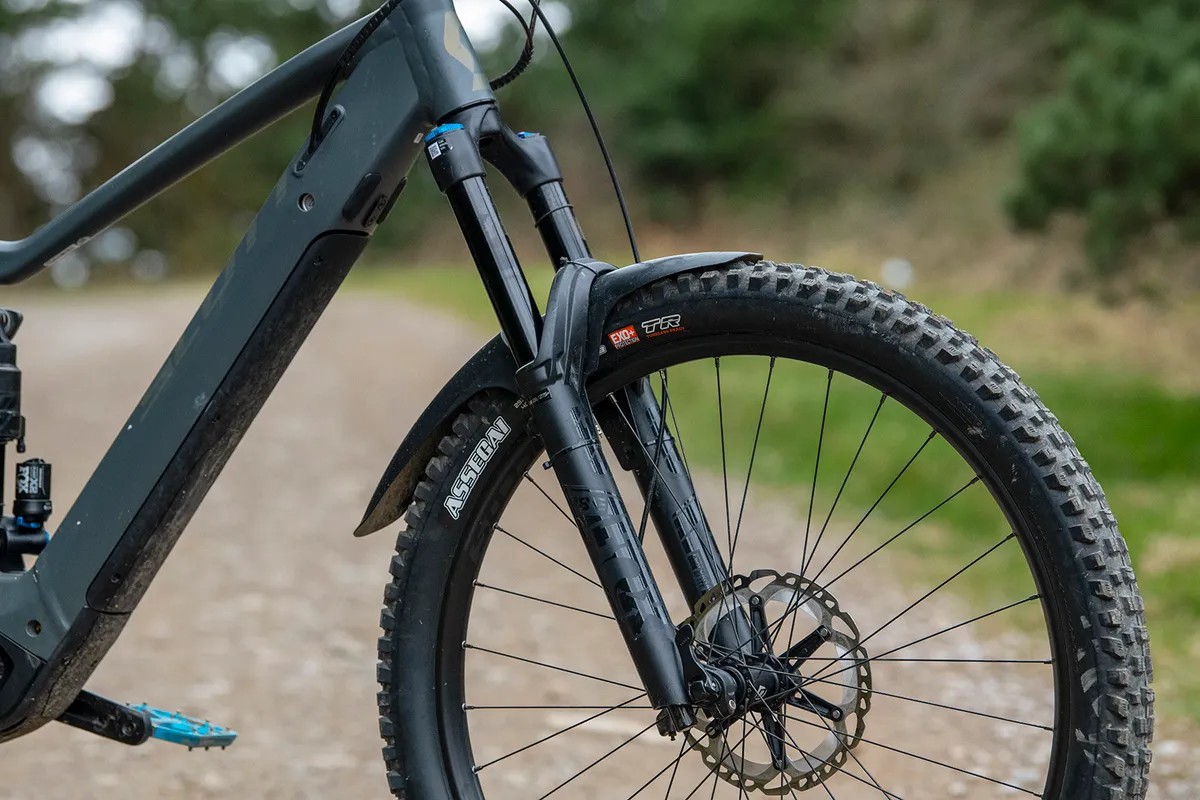
The Fox suspension fitted to the Ransom was easy to set up. I installed three volume-reducer spacers in the fork’s air spring and initially inflated it to 98psi. During testing, I reduced pressure to 93psi, which gave me 37mm/20.5 per cent sag, and didn’t change it for the remainder of the test period.
After initially trying the shock with no volume-reducer spacers, I added a single volume spacer during testing because I found the bike used its mid- and end-stroke too easily. Inflated to 195psi, the shock had 18mm or 27.6 per cent sag.
I ran both the fork and shock’s rebound and compression-damping adjusters in the fully open position for the duration of the test.
Once I’d tried the high-geometry position, I set the Ransom in its low position for the duration of the test period.
I inflated the tyres according to the trail conditions, but the high volume EXO+ casings required higher pressures than lower-volume versions or ones with a thicker casing. The increased pressure protected me against punctures and also provided increased sidewall stability.
Scott Ransom eRide 910 climbing performance
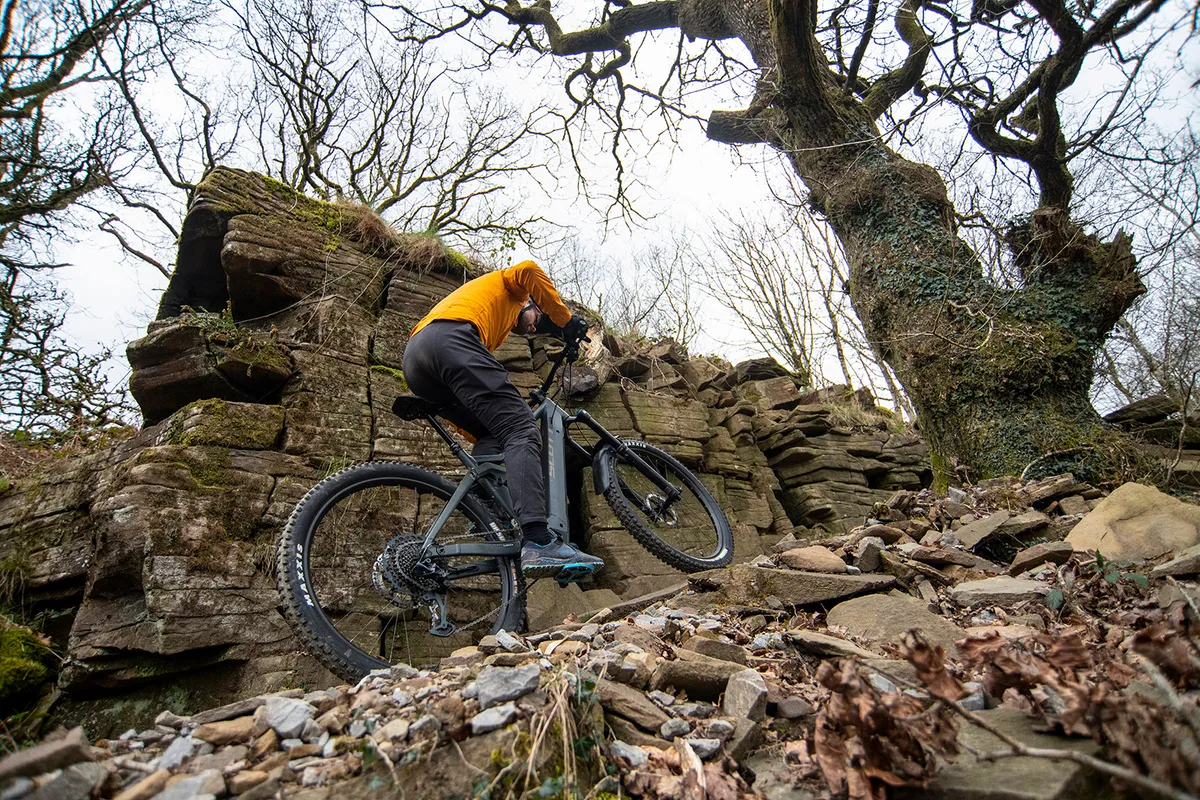
Heading uphill, the Ransom’s position is comfortably neutral thanks to its relatively steep seat tube angle and stout top tube figures.
This meant my weight felt evenly distributed between the front and back wheels, with the lengthy chainstays accentuating the feeling of sitting in the middle of the bike.
Thanks to the seat tube angle, the bottom bracket didn’t feel as though it was in front of my hips, which helped improve comfort and pedalling efficiency.
Not only did most of my body’s weight feel as though it was concentrated through my sit bones rather than through my hands, I also didn’t need to shift onto the saddle’s nose or lower my shoulder towards the bars to stop the front wheel lifting, even on very steep climbs.
The same was true for stopping or limiting wheelspin, where drive was easy to control with subtle weight shifts that meant my position barely deviated from its central point.

The long-travel, impressively supple suspension meant the rear shock was able to keep the back wheel in contact with the ground even over the choppiest of terrain, and the rear end remained impressively active when I was pedalling.
At 353.3mm, the bottom bracket height didn’t cause any unexpected rock strikes, and I was able to stay on the gas even through chunky, rocky terrain.
Frustratingly, the weakest link in the Ransom’s ability to climb is its speed-focused rear Dissector tyre. It was easy to wheelspin on soft or damp mud, where its tread pattern didn’t dig into the ground.
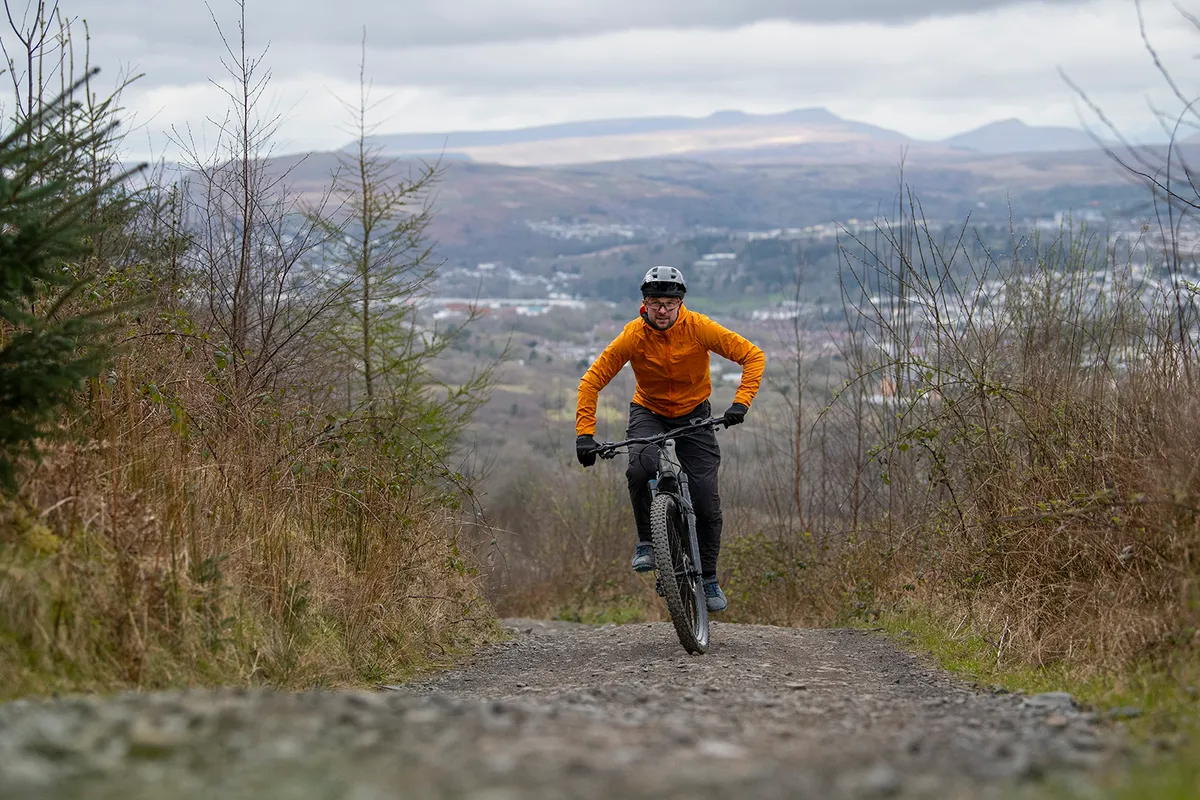
Equally, the high-volume but thin-casing carcass suffered from a lack of smoothness on rough ground, further decreasing grip.
Finally, because the tread isn’t well-spaced or very aggressive, and the 3C MaxxTerra compound is quite tough, it tended to slip and slide on wet roots and rocks rather than chew onto them.
This was the most disappointing aspect of the Ransom on the climbs, but also contributed to how it rode on the downs.
Battery life

Using the bike in its eMTB or Turbo modes reduced battery life significantly, where I was lucky to hit 1,200m of ascending on a single charge.
However, in those modes the immense power on offer from the Bosch Performance Line CX motor is addictive, and it feels massively natural. Coupled with the Ransom’s long-travel chassis, the two are a very good match.
In Eco mode, it was possible to exceed 2,000m of climbing on a single charge, which is similar to other Bosch-powered electric bikes.
Scott Ransom eRide 910 descending performance
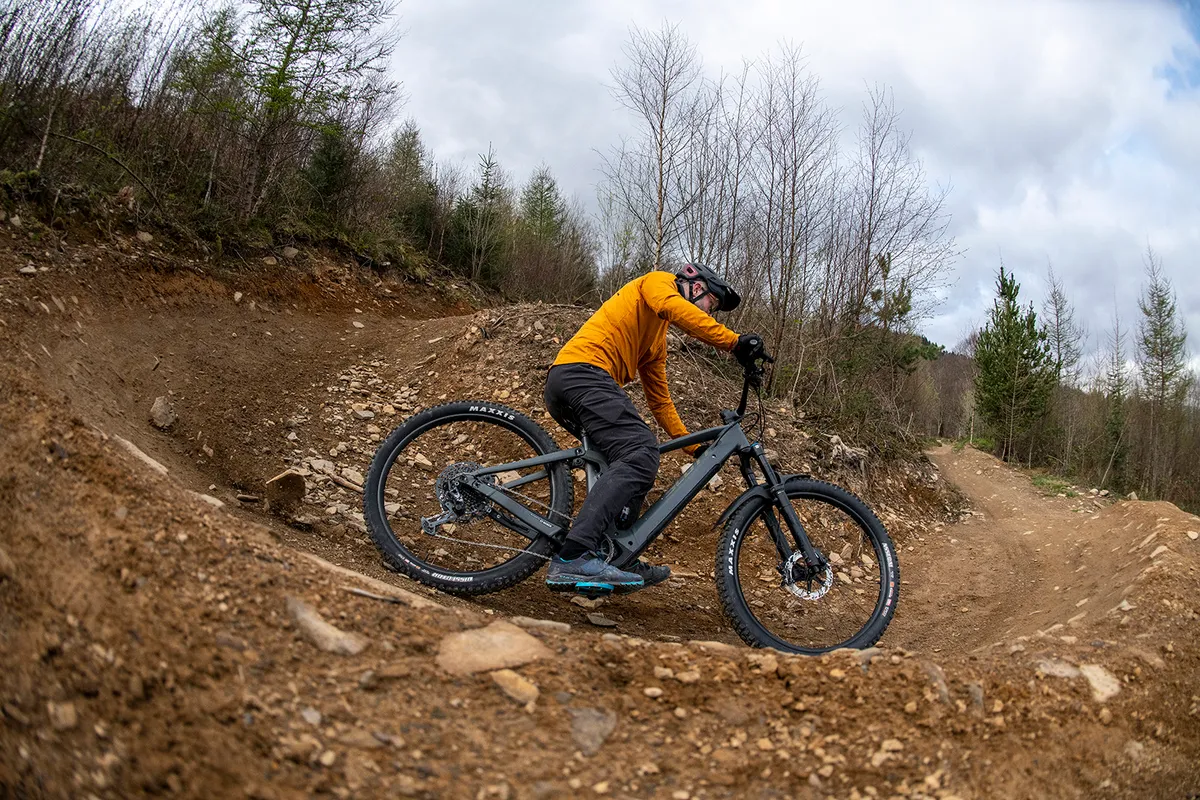
The Ransom’s ride was distinctly raw in feel. Small bumps such as rocks and roots embedded in the trail were frequently reverberated through the chassis into my hands and feet, which caused early fatigue compared to smoother-feeling bikes.
I pinpointed the undamped and taut feel to the tyre carcasses, where more air pressure was needed to retain their shape and support in high-load corners or compressions.
Furthermore, this was compounded by a lack of chemical traction on wet roots and rocks, where the tyres would slide across their surface or be deflected by the bump’s leading edge.
Frequently, the tyres would make a ‘thrumping’ noise down the trail as they caught the edge of rocks but were unable to deform around them, and instead were getting pinged off them.
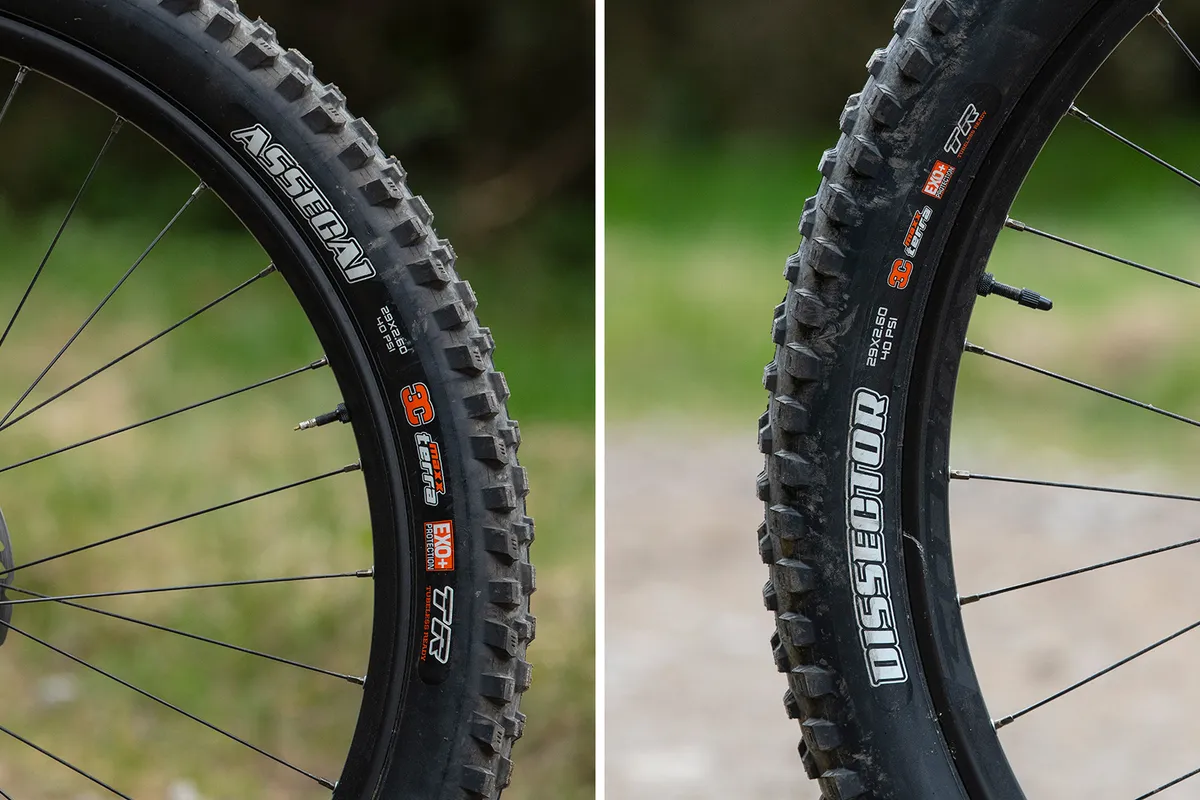
Equally, on rough hardpack and greasy off cambers, the lack of tyre damping meant that holding a line was tricky, where the tyres frequently scrabbled to gain traction and lacked grip.
This meant the bike’s limits were much lower and quicker to find than they would have been with thicker-casing tyres and corresponding lower air pressures.
Essentially, they reduced control and in certain conditions made descending unnecessarily hectic.
The final nail in the Ransom’s tyre coffin was the lack of braking traction the Dissector offered. Shimano’s 4-pot brakes were quick to overwhelm its grip, locking up the rear wheel.
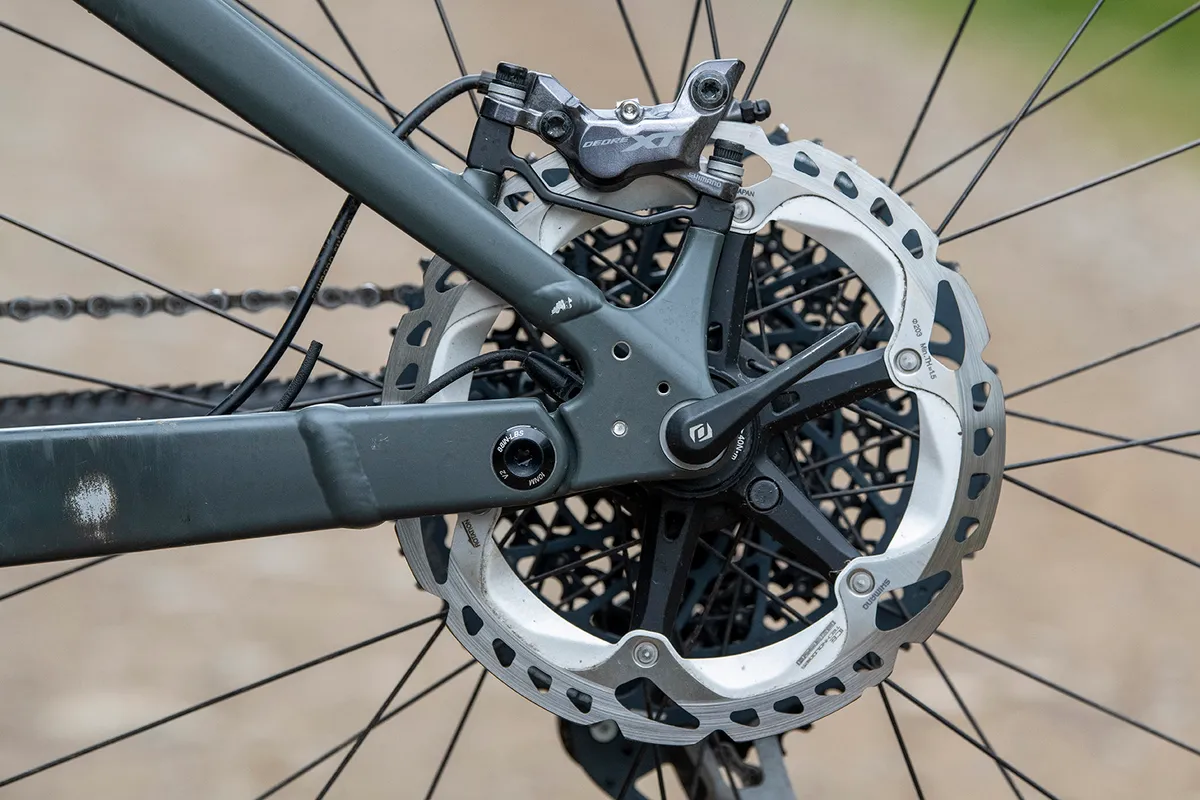
This meant more braking happened with the front brake, upsetting the bike’s balance and further inhibiting flow.
It wasn’t all bad though. Looking beyond the tyres, the Ransom has plenty of redeeming qualities.
It displays an impressively poppy and lively ride characteristic, where changing direction down the trail is both easy and intuitive.
This liveliness defies the headline suspension-travel figure, and it tended to feel as agile as a lighter-weight trail bike rather than the long-travel monster it looks like.
This eagerness to manoeuvre meant muscling it around on flat and steep tighter trails was a breeze. This made it much easier to ride quicker, where compared to bikes such as the Whyte E-180, less commitment was required to get it to ride any chosen line.
The hand-to-feet relationship was also very easy to get along with. The reach isn’t overly long, meaning I didn’t need a mental recalibration when hopping on the Ransom, and neither is it so short that the front of the bike felt cramped. This helped me ride quickly right away.
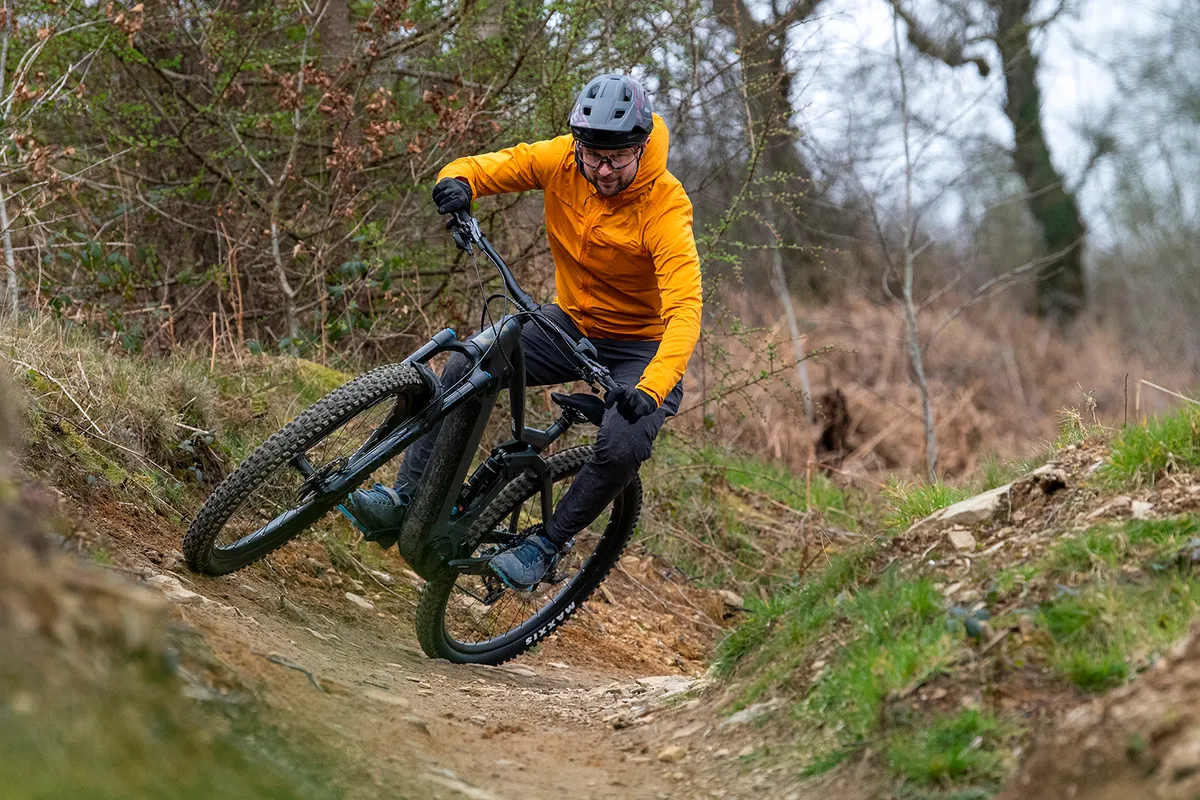
The 64-degree head tube angle could have been slightly slacker, especially given the bike’s relative low weight and its other figures.
Riding steep, on-the-brakes turns, the front wheel tended to tuck or steer harder when it was loaded up in the apex of the turn.
Slackening the head angle would shift the front wheel further away from the centre of the bike and better preserve its dynamic geometry. An added benefit would be increased stability at higher speeds.
The motor and battery’s positions make the Ransom a tall bike. Its standover height and seat tube length are both big. Overall, this won’t be a problem for people with longer legs, but shorter riders wanting longer reach figures are unlikely to fit the next size up.
How does the Scott Ransom eRide 910 compare?
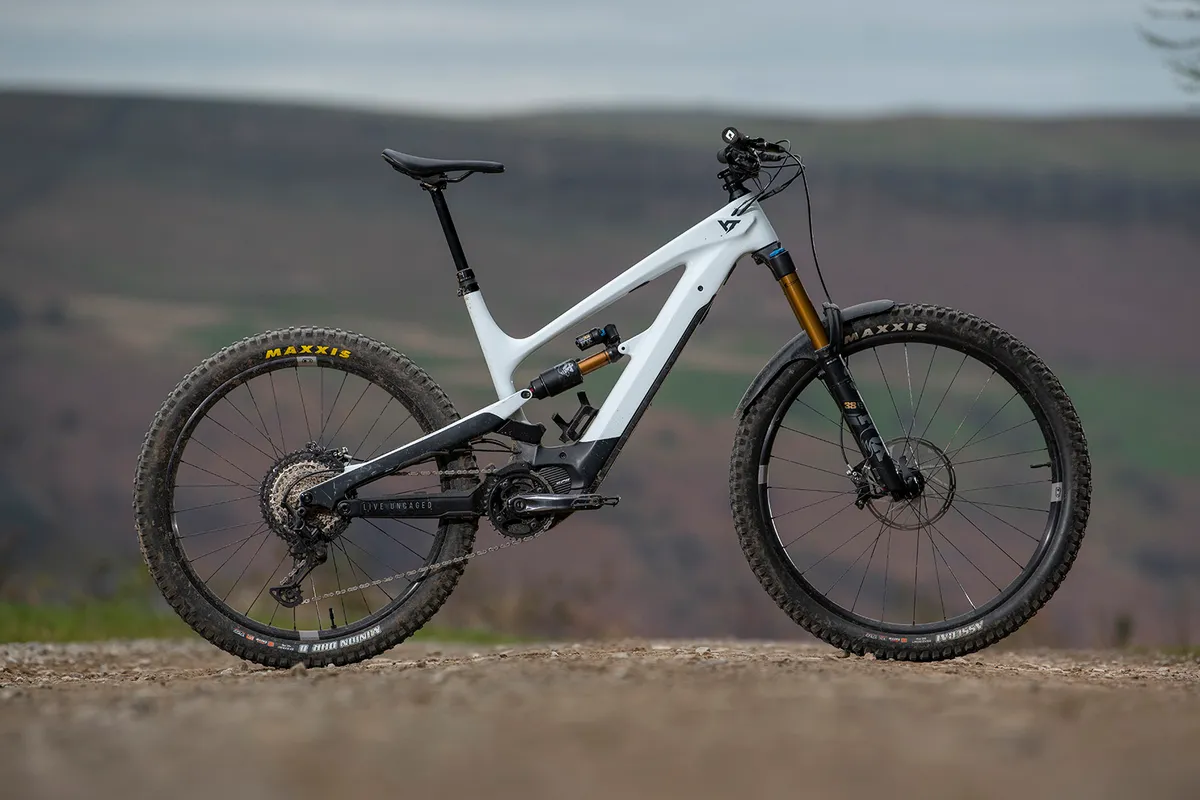
The Ransom is as intuitive to ride as the Nukeproof Megawatt or YT Decoy, but has distinct disadvantages against both.
Compared to the Megawatt, it’s not as stable at speed or on steeper trails and its tyres are much less grippy. It also feels a lot taller – thanks to the standover height and seat tube – especially when seated.
The Decoy, on the other hand, despite also having a long seat tube, squats down in the turns and doesn’t feel as easily pinged off-line as the Scott. That’s mostly thanks to the Synthesis wheels, because the tyres are the same in terms of compound, casing and size.

This highlights the importance of certain spec choices, where one issue – in this case traction and control – can be well mitigated against by another component.
The Bosch motor is fantastic, and in Eco mode is frugal enough compared to Shimano’s EP8. Although the higher assistance modes drain battery quicker than the Shimano equivalent, the extra grin-inducing power is well worth it.
How we tested
Despite this being the inaugural edition of eMTB Bike of the Year test, we’ve had plenty of experience testing ebikes to their absolute limits. That means finding out which of these eight bikes is the best electric mountain bike currently on sale was made a little easier.
Although that’s not say our job was simple, and choosing a winner came down to the wire, where the second and first place bikes swapped positions more times than we checked our tyre and shock pressures.
The majority of the ebike testing happened in Scotland’s Tweed Valley, home to the legendary Glentress trail centre, Golfie enduro tracks and Innerleithen downhill runs.
The terrain we tested the bikes on, therefore, was wide in scope and representative of what a modern enduro bike should be able to handle, whether that was gravity-fuelled laps on the DH tracks, epic enduro missions with long descents or gruelling trail rides with hours in the saddle.
To win this year’s test, we were looking for a bike that offered the best all-round package with fewest compromises and was able to perform on every type of riding we could throw at it.
In an ode to a bike tester’s cliché, it had to descend like a downhill bike, pedal and climb like a cross-country bike and be as comfortable to ride as an enduro bike.
Our 2022 eMTB Bike of the Year contenders are:
Scott Ransom eRide 910 bottom line
The Ransom’s tyres limit how hard it can be pushed and how much it helps you out on the types of trails its long travel and burly components will have you instinctively aiming for.
It’s a shame such a small spec choice has had such a profound impact on how it rides.
Given the £6,500 asking price, it’s unfair to expect consumers to drop another £180 on more appropriate tyres before heading out on the trails.

Looking beyond the tyres, there’s plenty to love about the Ransom. It’s intuitive and forgiving to ride quickly, and its geometry is well suited to all-day epics and most gnarly enduro trails.
That said, the Nukeproof Megawatt shares many of the Ransom’s easy-going qualities, just without any of the drawbacks such as a tall frame.
Product
| Brand | scott |
| Price | 14500.00 AUD,7199.00 EUR,6499.00 GBP |
| Weight | 24.8700, KILOGRAM (L) - without pedals |
Features
| Fork | Fox 38 Performance Elite GRIP2 EVOL, 180mm (7in) travel |
| br_stem | Sycros XM1.5, 40mm |
| br_chain | SRAM NX Eagle |
| br_frame | Alloy, 180mm (7in) travel |
| br_motor | Bosch Performance Line CX/Bosch PowerTube 625Wh/Bosch Purion |
| Tyres | Maxxis Assegai 3C Maxx Terra EXO+ TR WT 29x2.6in (f), Maxxis Dissector 3C Maxx Terra DoubleDown TR WT 29x2.6in (r) |
| br_brakes | Shimano XT M8120, 203/203mm rotors |
| br_cranks | SRAM X1, 34t |
| br_saddle | Syncros Tofino 1.5 Regular |
| br_wheels | Syncros MD30 on Formula hubs |
| br_headset | ACROS Blocklock |
| br_shifter | SRAM NX Eagle Single Click |
| br_cassette | SRAM XG-1275, 10-52t |
| br_seatpost | Fox Transfer (dropper) |
| br_gripsTape | Syncros Pro Lock-on |
| br_handlebar | Syncros Hixon 1.5 Rise, 800mm |
| br_rearShock | Fox Float X2 Performance |
| br_availableSizes | S, M, L, XL |
| br_rearDerailleur | SRAM X01 Eagle (1x12) |
